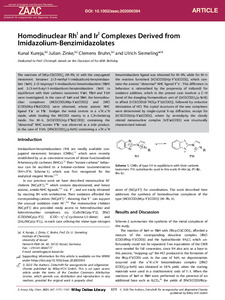| dc.date.accessioned | 2021-06-17T10:18:34Z | |
| dc.date.available | 2021-06-17T10:18:34Z | |
| dc.date.issued | 2020-11-19 | |
| dc.identifier | doi:10.17170/kobra-202106094099 | |
| dc.identifier.uri | http://hdl.handle.net/123456789/12934 | |
| dc.description.sponsorship | Gefördert im Rahmen des Projekts DEAL | ger |
| dc.language.iso | eng | eng |
| dc.rights | Namensnennung 4.0 International | * |
| dc.rights.uri | http://creativecommons.org/licenses/by/4.0/ | * |
| dc.subject | carbenes | eng |
| dc.subject | coordination modes | eng |
| dc.subject | Iridium; Rhodium | eng |
| dc.subject | x-ray diffraction | eng |
| dc.subject.ddc | 540 | |
| dc.title | Homodinuclear Rhˡ and Irˡ Complexes Derived from Imidazolium-Benzimidazolates | eng |
| dc.type | Aufsatz | |
| dcterms.abstract | The reactions of [M(μ-Cl)(COD)]2 (M=Rh, Ir) with the conjugated mesomeric betaines 2-(3-methyl-1-imidazolium)-benzimidazolate (1aH), 2-(3-isopropyl-1-imidazolium)-benzimidazolate (1bH) and 2-(3-tert-butyl-1-imidazolium)-benzimidazolate (1cH) in equilibrium with their carbenic tautomers 1’aH, 1’bH and 1’cH were investigated. In the case of 1aH and 1bH, the homodinuclear complexes [MCl(COD){M(μ-1’a)(COD)}] and [MCl(COD){M(μ-1’b)(COD)}] were obtained, whose anionic NHC ligand 1’a− or 1’b− bridges the metal centres in a κ1N : κ1N mode, while binding the M(COD) moiety in a C,N-chelating mode. For M=Ir, [IrCl(COD){Ir(μ-1’’b)(COD)}] containing the “abnormal” NHC isomer 1’’b− was observed as a side product. In the case of 1’cH, [{RhCl(COD)}2(μ-1cH)] containing a κ1N : κ1N benzimidazolato ligand was obtained for M=Rh, while for M=Ir the reaction furnished [IrCl(COD){Ir(μ-1’’c)(COD)}], which contains the anionic “abnormal” NHC ligand 1’’c−. This difference in behaviour is rationalised by the propensity of iridium(I) for oxidative addition, which in the present case involves a C−H bond of the dangling formamidium unit of [{IrCl(COD)}2(μ-1cH)] to afford [IrICl(COD){IrIIIHCl(μ-1’’c)(COD)}], followed by reductive elimination of HCl. The crystal structures of the new complexes were determined by single-crystal X-ray diffraction, except for [IrCl(COD){Ir(μ-1’a)(COD)}], where by serendipity the closely related mononuclear complex [Ir(1’a)(COD)] was structurally characterised instead. | eng |
| dcterms.accessRights | open access | |
| dcterms.creator | Kureja, Kunal | |
| dcterms.creator | Zinke, Julian | |
| dcterms.creator | Bruhn, Clemens | |
| dcterms.creator | Siemeling, Ulrich | |
| dc.relation.doi | doi:10.1002/zaac.202000394 | |
| dc.subject.swd | Carbene | ger |
| dc.subject.swd | Chemische Bindung | ger |
| dc.subject.swd | Iridium | ger |
| dc.subject.swd | Rhodium | ger |
| dc.subject.swd | Röntgenbeugung | ger |
| dc.title.subtitle | Dedicated to Prof. Christoph Janiak on the Occasion of his 60th Birthday | eng |
| dc.type.version | publishedVersion | |
| dcterms.source.identifier | eissn:1521-3749 | |
| dcterms.source.issue | Issue 11 | |
| dcterms.source.journal | Zeitschrift für anorganische und allgemeine Chemie (ZAAC) = Journal of inorganic and general chemistry | ger |
| dcterms.source.pageinfo | 1173-1181 | |
| dcterms.source.volume | Volume 647 | |
| kup.iskup | false | |


